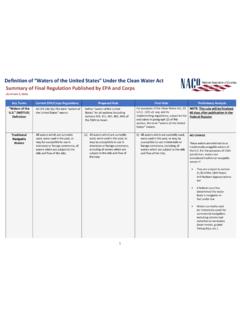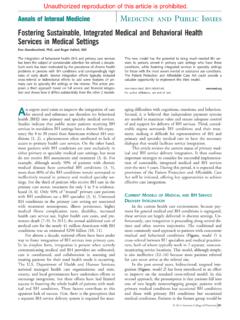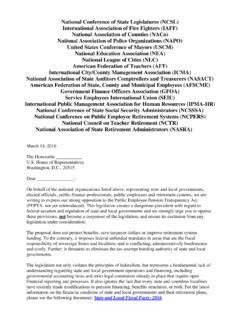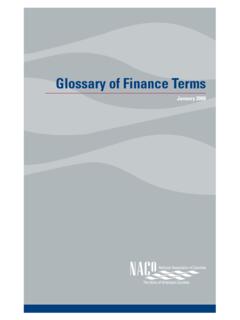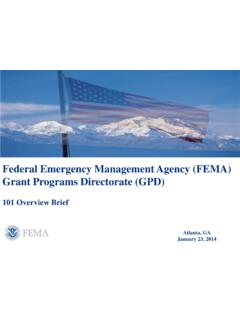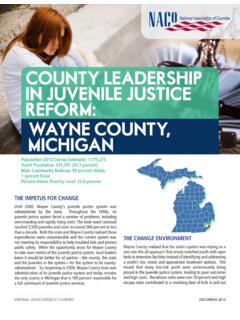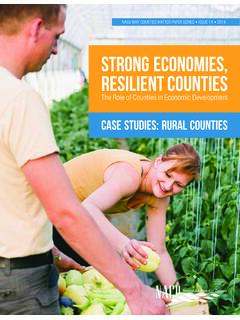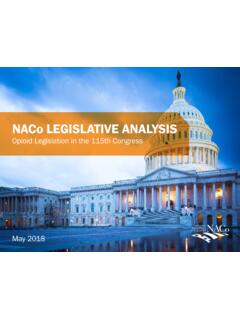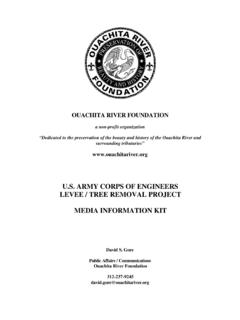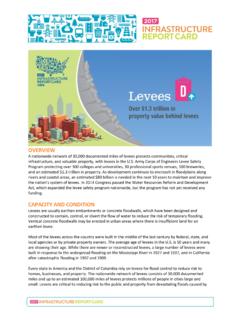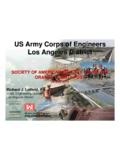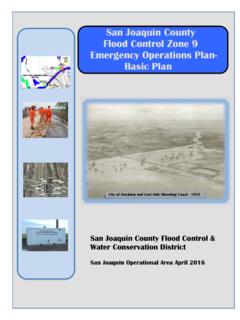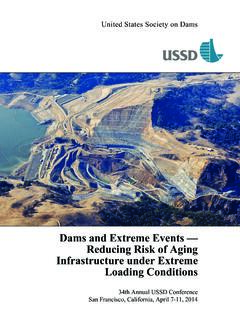Transcription of New “Waters of the United States” Definition Released
1 NATIONAL ASSOCIATION OF COUNTIES | 25 MASSACHUSETTS AVENUE, SUITE 500 | WASHINGTON, 20001 | | FAX | | | | County Action Needed New Waters of the United states Definition Released Counties are strongly encouraged to submit written comments on potential impacts of the proposed regulation to the Federal Register On April 21, the Environmental Protection Agency (EPA) and the Army Corps of Engineers (Corps) jointly Released a new proposed rule Definition of Waters of the Under the Clean Water Act that would amend the Definition of waters of the and expand the range of waters that fall under federal jurisdiction.
2 The proposed rule, published in the Federal Register, is open for public comment until November 14, 2014. The proposed rule uses Environmental Protection Agency s (EPA) draft report on Connectivity of Stream and Wetlands to Downstream Waters: A Review and Synthesis of the Scientific Evidence, which is currently undergoing review by EPA s Science Advisory Board, as a scientific basis for the new Definition . The report focuses on over 1,000 scientific reports that demonstrate the interconnectedness of tributaries, wetlands, and other waters to downstream waters and the impact these connections have on the biological, chemical and physical relationship to downstream waters.
3 Why Waters of the Regulation Matters to Counties The proposed waters of the regulation from EPA and the Corps could have a significant impact on counties across the country, in the following ways: Seeks to define waters under federal jurisdiction: The proposed rule would modify existing regulations, which have been in place for over 25 years, regarding which waters fall under federal jurisdiction through the Clean Water Act (CWA). The proposed modification aims to clarify issues raised in recent Supreme Court decisions that have created uncertainty over the scope of CWA jurisdiction and focuses on the interconnectivity of waters when determining which waters fall under federal jurisdiction.
4 Because the proposed rule could expand the scope of CWA jurisdiction, counties could feel a major impact as more waters become federally protected and subject to new rules or standards. Potentially increases the number of county-owned ditches under federal jurisdiction: The proposed rule would define some ditches as waters of the if they meet certain conditions. This means that more county-owned ditches would likely fall under federal oversight. In recent years, Section 404 permits have been required for ditch maintenance activities such as cleaning out vegetation and debris. Once a ditch is under federal jurisdiction, the Section 404 permit process can be extremely cumbersome, time-consuming and expensive, leaving counties vulnerable to citizen suits if the federal permit process is not streamlined.
5 NATIONAL ASSOCIATION OF COUNTIES | 25 MASSACHUSETTS AVENUE, SUITE 500 | WASHINGTON, 20001 | | FAX | | PAGE 2 Applies to all Clean Water Act programs, not just Section 404 program: The proposed rule would apply not just to Section 404 permits, but also to other Clean Water Act programs. Among these programs which would become subject to increasingly complex and costly federal regulatory requirements under the proposed rule are the following: Section 402 National Pollution Discharge Elimination System (NPDES) program, which includes municipal separate storm sewer systems (MS4s) and pesticide applications permits (EPA Program) Section 303 Water Quality Standards (WQS) program, which is overseen by states and based on EPA s waters of the designations Other programs including stormwater, green infrastructure, pesticide permits and total maxiumum daily load (TMDL) standards Background Information The Clean Water Act (CWA)
6 Was enacted in 1972 to restore and maintain the chemical, physical and biological integrity of our nation s waters and is used to oversee federal water quality programs for areas that have a water of the The term navigable waters of the was derived from the Rivers and Harbors Act of 1899 to identify waters that were involved in interstate commerce and were designated as federally protected waters. Since then, a number of court cases have further defined navigable waters of the to include waters that are not traditionally navigable. More recently, in 2001 and 2006, Supreme Court cases have raised questions about which waters fall under federal jurisdiction, creating uncertainty both within the regulating agencies and the regulated community over the Definition of waters of the In 2001, in Solid Waste Agency of Northern Cook County v.
7 United states Army Corps of Engineers (531 , 2001), the Corps had used the Migratory Bird Rule wherever a migratory bird could land to claim federal jurisdiction over an isolated wetland. The Court ruled that the Corps exceeded their authority and infringed on states water and land rights. In 2006, in Rapanos v. United states , (547 715, 2006), the Corps were challenged over their intent to regulate isolated wetlands under the CWA Section 404 permit program. In a 4-1-4 split decision, the Court ruled that the Corps exceeded their authority to regulate these isolated wetlands. The plurality opinion states that only waters with a relatively permanent flow should be federally regulated.
8 The concurrent opinion stated that waters should be jurisdictional if the water has a significant nexus with a navigable water, either alone or with other similarly situated sites. Since neither opinion was a majority opinion, it is unclear which opinion should be used in the field to assert jurisdiction, leading to further confusion over what waters are federally regulated under CWA. The newly proposed rule attempts to resolve this confusion by broadening the geographic scope of CWA jurisdiction. The proposal states that waters of the under federal jurisdiction include navigable waters, interstate waters, territorial waters, tributaries (ditches), wetlands, and other waters.
9 It also redefines or includes new definitions for key terms adjacency, riparian area, and flood plain that could be used by EPA and the Corps to claim additional waters as jurisdictional. NATIONAL ASSOCIATION OF COUNTIES | 25 MASSACHUSETTS AVENUE, SUITE 500 | WASHINGTON, 20001 | | FAX | | PAGE 3 states and local governments play an important role in CWA implementation. As the range of waters that are considered waters of the increase, states are required to expand their current water quality designations to protect those waters. This increases reporting and attainment standards at the state level.
10 Counties, in the role of regulator, have their own watershed/stormwater management plans that would have to be modified based on the federal and state changes. Changes at the state level would impact comprehensive land use plans, floodplain regulations, building and/or special codes, watershed and stormwater plans. Examples of Potential Impact on Counties County-Owned Public Infrastructure Ditches The proposed rule would broaden the number of county maintained ditches roadside, flood channels and potentially others that would require CWA Section 404 federal permits. Counties use public infrastructure ditches to funnel water away from low-lying roads, properties and businesses to prevent accidents and flooding incidences.
